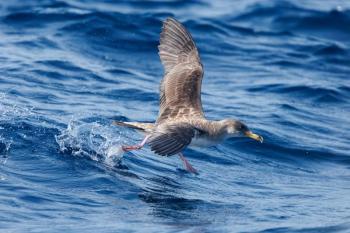Migration or Something Else?
We wrote last week about our luck visiting Wharton Point in Brunswick as the tide turned and shorebirds of various kinds made themselves visible on the expanding mudflats. Well, someone else was even luckier there a few days after we were. They discovered a very large, white bird—an American white pelican. That’s a bird that we’ve never laid eyes on in Maine, although we’ve seen it many times in many other places in the U.S. and Canada.
This reminded us of the anhinga that appeared in Somerville, Maine earlier this summer and got us wondering: Were these birds migrating?
No, not in the sense that they were moving from a breeding area to a wintering area and back. These birds were moving long distances, just not in the specific way that we would consider migration.
Many birds make long journeys that don’t fit into the category that we typically call “migration.”
Herons and egrets are famous for making long journeys north in late-summer after the breeding season is over. Great egrets—all white with black legs and yellow bill—often show up well north of their breeding range. Here in Maine, birders have been finding them this August even across Aroostook County.
A wood stork has been treating Montreal, Quebec-area birders with its presence this past week. That’s another species that will sometimes wander north after the breeding season is over. Will Maine play host to one (or will this one wander into Maine) at some point in the coming weeks?
Many breeding common and roseate terns from along the Maine coast and Nova Scotia leave with their fledglings in late summer for the coast of Massachusetts. There they take advantage of some abundant small fish populations to fatten up a few weeks before eventually heading south in true migration, some to the coast of Brazil for the winter.
Less is known about the movements of most songbirds after the breeding season has ended. Swallows congregate near meadows, marshes, and blueberry barrens (as we wrote about a few weeks ago) even starting in late July. Most seem to disappear soon after as they start their actual migrations south.
Warblers join chickadee and titmouse flocks at this time of year in our area. How many are local birds that nested or were hatched within a few miles away? How many are from hundreds of miles away? We’ve had a few immature or female American redstarts flitting around the lilac bushes in the yard this week, flashing their yellow tail patches. Are they local birds or visitors from far away?
Some seabirds make very long movements in the course of foraging for their young, flying hundreds or in some species, thousands of miles searching for food. Leach’s storm-petrels nesting right here on islands off the Maine coast have been tracked flying 250 miles one-way to forage for their young near the Northeast Canyons and Seamounts National Monument 100 miles southeast of Cape Cod.
Another seabird, the Cory’s shearwater, is seen in small numbers off the Maine coast in summer. Whale watch trips from Boothbay Harbor having been finding fair numbers of them over the last few weeks. The closest known breeding area is in the Azores, nearly 200 miles away. Are the birds off our coast breeding birds on very long foraging trips for their young? Or are they non-breeders or failed breeders just hanging out for the summer before they head south for the winter?
Any aspiring ornithologists out there looking for some great unanswered mysteries to solve?
Jeffrey V. Wells, Ph.D., is a Fellow of the Cornell Lab of Ornithology and Vice President of Boreal Conservation for National Audubon. Dr. Wells is one of the nation's leading bird experts and conservation biologists. He is a coauthor of the seminal “Birds of Maine” book and author of the “Birder’s Conservation Handbook.” His grandfather, the late John Chase, was a columnist for the Boothbay Register for many years. Allison Childs Wells, formerly of the Cornell Lab of Ornithology, is a senior director at the Natural Resources Council of Maine, a nonprofit membership organization working statewide to protect the nature of Maine. Both are widely published natural history writers and are the authors of the popular books, “Maine’s Favorite Birds” (Tilbury House) and “Birds of Aruba, Bonaire, and Curaçao: A Site and Field Guide,” (Cornell University Press).


.jpg)






























.png)
.png)

